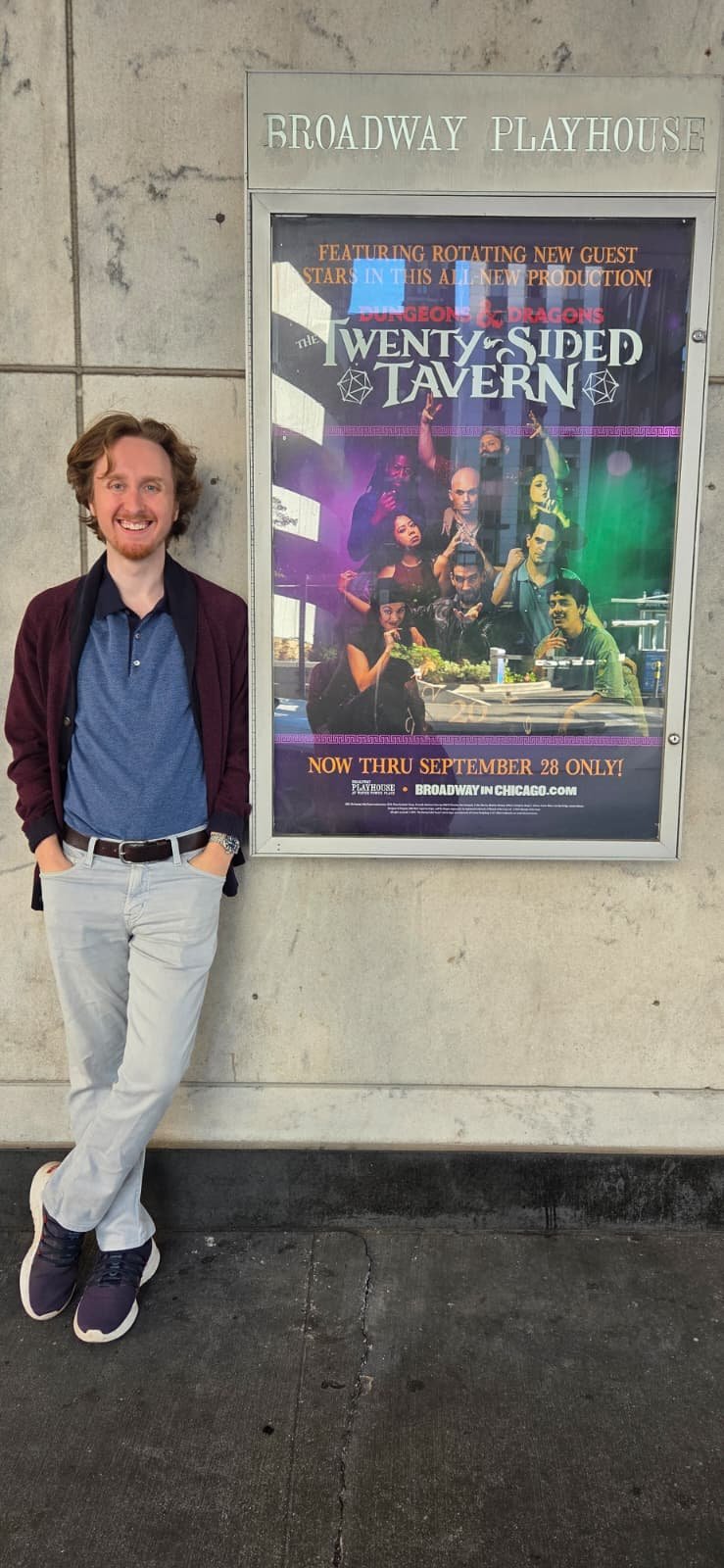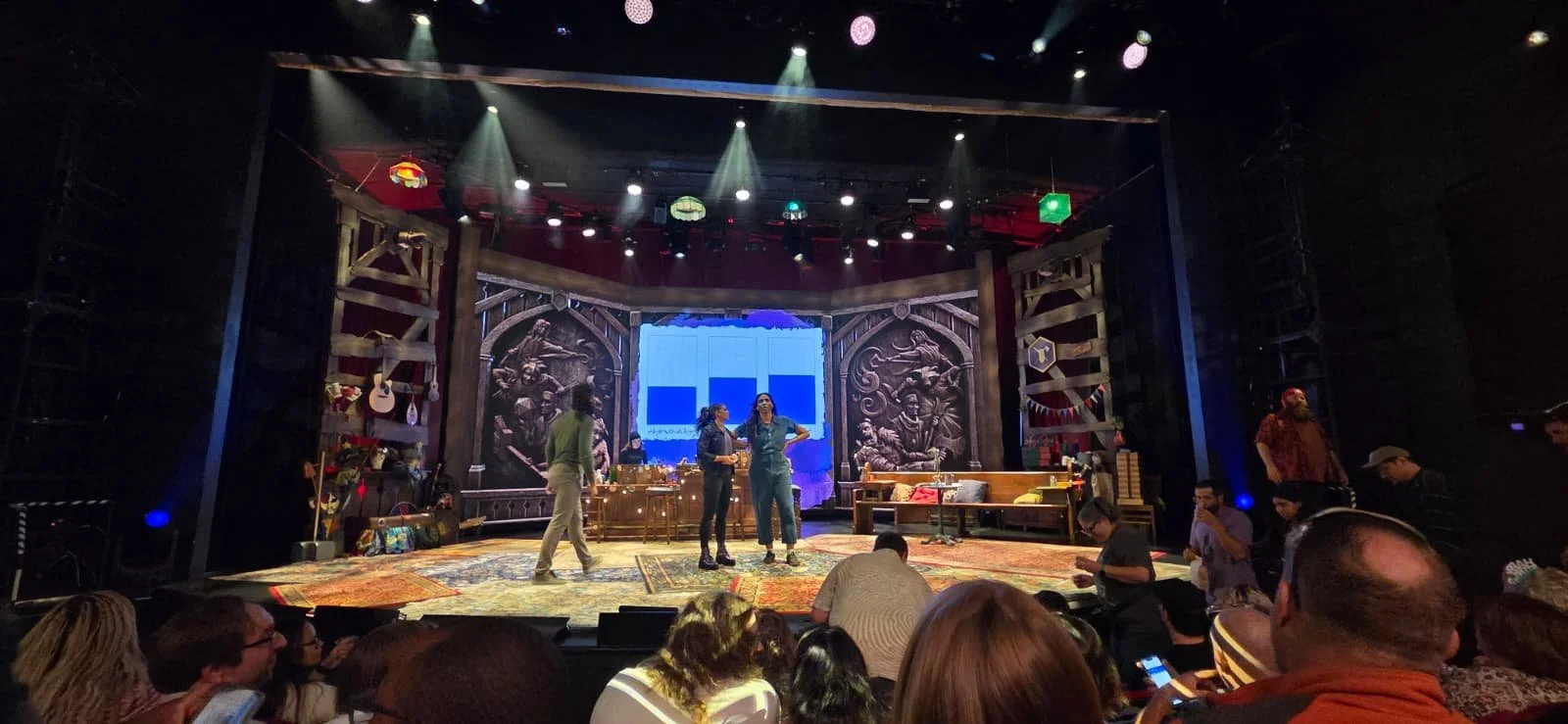Review: Is The Twenty Sided Tavern a Good Introduction to Dungeons and Dragons?
“Ale….”
“And well met!”
That call and response has been on repeat in my mind since the opening of The Twenty-Sided Tavern, a touring Dungeons and Dragons-themed improv show.
Recently, Jessica and I drove down to Chicago to catch the performance.
Are Jessica’s elf ears long? All the better to hear you with!
As a longtime fan of the world’s most popular tabletop role-playing game, I was curious how they’d bring the notoriously nerdy pastime to life on the stage.
It’s an interesting amalgam of ‘actual play’ (the name for recorded games of Dungeons and Dragons, like the popular show Critical Role), improv comedy with constant audience suggestions, and a choose-your-own adventure book where the audience gets to vote on major decisions.
The Story
Get your tickets now!
Here are the bare bones: a trio of adventurers meet in a bar. They’re entrusted by another figure to defeat a great evil. They go from location to location, gathering the artifacts necessary to do so.
Pretty familiar, right? Sounds like every fantasy story ever written.
The joy comes from how they color within those lines. The audience gets to suggest nearly everything — from what sort of heroes the adventurers are to the villain they’re trying to defeat. It is live, dynamic, and kinetic.
Each hero has their own skill set. Every time they want to do something of significance, they roll a 20-sided die and add their relevant skill to the total. If they meet a certain number, it succeeds. If not, they fail, but that failure propels the story forward.
Classic DND!
The Cast
Based on the show’s website, the cast rotates. But it looks like every show has two emcees/game masters and three performers.
Our game masters were Madelyn Murphy (the Dungeon Master/DM, who narrates the plot, tells the players what can and can’t be done, and performs as every side character) and Cassidy Sledge (who serves as technical support — lights, props, rule clarifications, and logistics — until the very end, when she stepped in to DM).
Being a DM is a notoriously difficult task.
You need to create a world for your players that gives them a satisfying direction to conquer while respecting their autonomy and often unpredictable choices.
You need to keep track of rules, character abilities, and moving pieces from social encounters to exploration to combat without letting anything feel bogged down.
You simultaneously perform the role of narrator and plenty of side characters.
You need to be as good at math as you are at doing character voices.
If there were a higher ed-sponsored degree to be a top-level DM, I think it would have a lower initial pass rate than the bar exam. Murphy passes that high bar.
Her accents and impressions are limited, but she winkingly leans into those limits. From doing an obnoxiously inaccurate French parody of Beauty and the Beast to a Frodo Baggins-inspired villain, she kept yes-and-ing everything the audience threw at her .
She sometimes lost track of the numbers or rules. Her best moment involved a huge final fight when she played a gelatinous ogre, shaking all over the stage while narrating the battle.
Sledge, the assistant, is clearly overjoyed to be there — how many nerds would leap at the opportunity to do this for a living?
I think she’s still finding her middle ground between RAS (rules as written) and ROC (rule of cool). Sometimes, she pointed out the strict rules of the game would not allow for some of the improvised audience-pleasing moments, but going through the strict letter of the law was clearly slowing down the flow.
Neither quite reached the level of the true top Dungeon Masters (some of whom you’ll see below). Both were more than capable of holding the crowd’s attention and respect.
The three players were R. Alex Murray (who played a fighter), RJ Christian (a thief), and guest star Aabria Iyengar (a mage).
Murray was the standout for me; he had the best one-liners, the best physical comedy (including a running romance with a DM-played side character), and a true character arc that was a little deeper than the zany improv performances around him.
Christian’s character was basically a gag — very little depth and a silly voice.
Iyengar’s mage was memorable for pretty badass choices in battle, but fell short of Murray’s standard.
I imagine it’s hard for traditional DND players — not historically great physical actors — to take their tabletop experience and command a stage. It’s easy to fall back on shticks, but I’d prefer a little more of an arc for each performer.
Some of the best moments involved bringing the audience on stage to play minigames, read lines for side characters, and re-roll failed dice checks for the performers.
And all of the actors were clearly willing and able to share the spotlight.
When I look at this picture, I see myself as a middle-aged dad.
The Takeaway
Adapting DND in any format is a Herculean task.
It’s such a unique artistic medium of expression with decades of lore.
I was curious who would come out and support it, but the theater was completely packed. Based on an early show of hands, around 40-50% of the crowd had never played before.
I think this show is a solid introduction to the game.
Huzzah!
It’s a pretty clear 8/10, with points deducted for having one battle too many at the expense of the character development that so many players love.
It’s certainly worth a watch — and maybe a rewatch, since no two shows are the same.
More importantly, it’s a gateway into the game that has changed how I — and many others — think about creativity, storytelling, friendship, and expression.
I love DND. I wrote a speech about how great it is and won six straight adult speaking championships with it — mostly based on how INTO IT I clearly was.
I talked about it in my MBA application (I have a wiki of the adventures I’ve guided my group through since 2020 that’s now over 200,000 words long). I recommend the game to anyone who wants to break out of their shell and start becoming a clearer communicator.
If you can’t make it out to see the show — or you already did and want more material — I recommend these videos (in order of digestibility).
Red Nose Day - Matt Mercer
This is a short one-on-one game between Stephen Colbert and internationally famous voice actor/Dungeon Master Matt Mercer. It was produced for a charity event. It’s under an hour long — a cute, short, sweet adventure that introduces all the basic mechanics.
Dungeons and Drag Queens - Dimension 20
Dungeon Master prodigy Brennan Lee Mulligan leads stars from RuPaul’s Drag Race through a classic world of swords and sorcery. They’re all fun performers and big personalities, but brand new to the game, so as they learn, you can learn.
You need a subscription to Dropout to watch beyond the first episode, but — if you really want to see more after that opener — that ~$7 price tag is 100% worth it for years’ worth of content.
This game is under 10 hours total — treat it like a season of The Last of Us or The White Lotus.
Fantasy High - Dimension 20
It’s another Brennan Lee Mulligan game.
He DMs a cast of CollegeHumor comedians through a combination of classic fantasy and 80s teen movies like The Breakfast Club, where a ragtag bunch of misfits training to become heroes in a fantasy take on modern suburbia uncover a dastardly conspiracy to take over the continent.
The comedy, drama, and mystery are perfectly balanced in a masterclass season with performers who deeply embody their characters and a DM who’s firing on all cylinders.
It’s over 30 hours, so buckle in, but the time flies by.
So is The Twenty-Sided Tavern the perfect show? No. Is it perfect DND? Also, no.
But it captures the messy, hilarious, collaborative heart of DND better than anything else I’ve seen on stage. It’s a night worth rolling the dice on.
“Ale…”
“And well met!”




